Magadha was one of the 16 Mahajanapadas, or ‘Great Kingdoms’ that existed in ancient India. This ancient kingdom was centered around southern Bihar, in the northeastern part of India. Much of the information regarding Magadha’s history is derived from written sources, which were written from a religious perspective, be it Hindu, Buddhist, or Jain. According to some of these accounts, the kingdom existed as early as the 2nd millennium BC. Modern scholarship, however, generally considers the rulers of this early Magadhan period to be semi-legendary figures.
The history of Magadha from the 6th century BC onwards, on the other hand, is taken more seriously. Although there are many uncertainties about Magadha, it played a significant role in India’s history, and two powerful Indian empires – the Maurya Empire and the Gupta Empire, have their origins in the core area of this ancient kingdom.
The First Kings of Magadha
According to the Puranas, Magadha was established during the 2nd millennium BC by the Brihadratha Dynasty. The dynasty is named after the first ruler of Magadha, Brihadratha, whose lineage is traced all the way back to Emperor Kuru of the Bharata Dynasty, via Kuru’s eldest son, Sudhanush.
According to the Vayu Purana , the Brihadratha Dynasty ruled Magadha for 1000 years. Most of the Puranas, including the Vayu Purana , mentions that this dynasty was succeeded by the Pradyota Dynasty, which ruled Magadha for 138 years. Other sources, however, state that the Pradyotas were the rulers of Avanti, in modern-day Madhya Pradesh, in central India.
In any case, during the 6th century BC, a new dynasty, the Haryanka Dynasty, is recorded to have been established at Magadha. The first ruler of this new dynasty was Bimbisara, who has connections with both Buddhism and Jainism. According to Buddhist sources, Bimbisara was a close friend of Suddhodana, the ruler of the Shakya, and the father of Siddhartha Gautama , the historical Buddha.
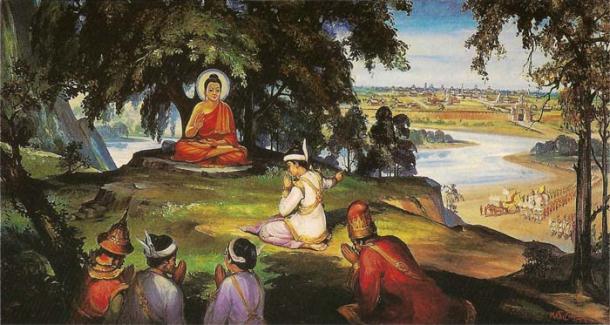
Painting of King Bimbisara offering his kingdom, Magadha, to the Buddha. (Hintha/ CC BY-SA 3.0 )
Why was Bimbisara Important?
Bimbisara is also said to have become the Buddha’s first royal patron. It was thanks to Bimbisara’s patronage that the Buddha was protected, and his teachings could be disseminated. According to Jain sources, Bimbisara was a friend of Mahavira, or Jina, the great teacher of Jainism. Due to his friendship with Mahavira, Jains believe that Bimbisara will, in his next cycle of existence, become a Tirthankara, i.e. a ‘fully realized being’.
Bimbisara is said to have become the ruler of Magadha at the age of 15. Bimbisara is considered to have been a virtuous ruler, and was known for his generosity and the justness of his rule. Although Bimbisara pursued expansionist politics, he was still able to maintain peaceful relations with most of his peers.
Bimbisara’s expansion of Magadha, along with his patronage of Buddhism, are said to have laid the territorial and religious foundations for Ashoka’s Mauryan Empire. Bimbisara met a rather tragic end at the age of 52. According to tradition, he was imprisoned by his own son, Ajatashatru, and starved to death. Some sources report that Bimbisara had already abdicated in favor of Ajatashatru, but was murdered by him anyways. Ironically, perhaps, Ajatashatru was also a patron of Buddhism, like his father before him.
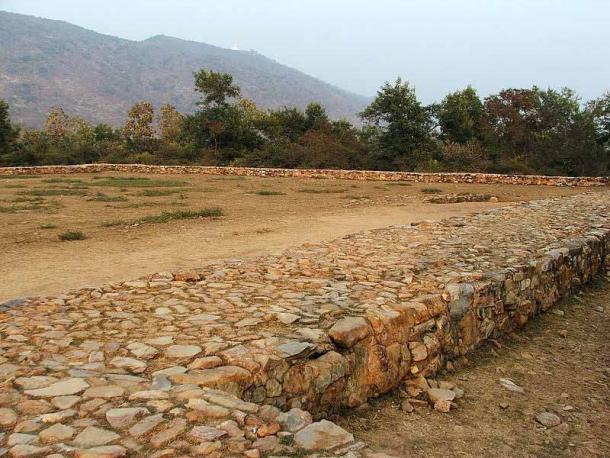
Remains of what has been identified as Bimbisara’s Jail, at Rajgir, Bihar, India. This is suspected of being the place where Prince Ajatasatru jailed his father King Bimbisara and starved him to death. Some jail equipment was found at the site, and the Grijjakuta hill (Vulture Peak) can be seen from the site. (BPG/ CC BY-SA 2.5 )
The Following Dynasties of the Magadha Kingdom
Bimbisara is said to have lived between the 6th and 5th centuries BC, and was succeeded by Ajatashatru in 493 BC. By the middle of the 5th century BC, the Haryanka Dynasty had been replaced by the Shishunaga Dynasty. The dynasty’s founder, Shishunaga, is an obscure figure, and may have been a viceroy of the Haryanka Dynasty at Kashi. Having seized power from his former masters, Shishunaga expanded Magadha, and succeeded in annexing the Avanti Kingdom.
This dynasty, however, was short-lived, and ended when Shishunaga’s son, Kalashoka, was brutally murdered. Other sources, however, claim that Shishunaga’s dynasty succeeded that of the Pradyotas. It is said that the people of Magadha rose up against the Pradyotas, overthrew them, and elected Shishunaga to be their new ruler. Perhaps this could be a reference to the Pradyotas of Avanti, rather than of Magadha?
In any event, the Shishunaga Dynasty is thought to have met its demise in 424 BC, and was replaced by the Nanda Dynasty. This dynasty was founded by Mahapadma Nanda, alleged to have been an illegitimate son of Mahanandin, the final ruler of the Shishunaga Dynasty. Tradition also states that Mahapadma was of low social origin, perhaps belonging to the Sudra caste, and that he had been an adventurer before ascending the throne of Magadha. Mahapadma’s early career is thought to have contributed to his approach in consolidating his kingdom, i.e. through ruthless conquests. Thus, the Nandas continued the systematic expansionist policy that their predecessors had pursued.
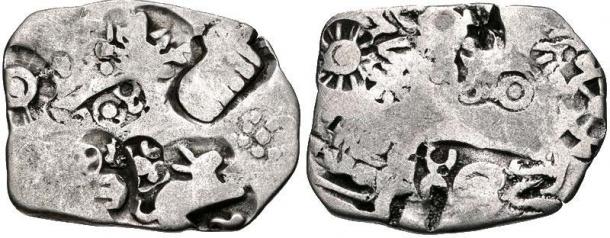
Magadha kingdom coin, circa 350 BC. (CNG Coins/ CC BY-SA 3.0 )
Mahapadma is recorded to have died at the age of 88. The Nanda Dynasty reigned for about a century. Thus, for most of its existence, the Nanda Dynasty was led by its founder. The different sources, however, disagree with each other as to the rulers of Magadha who succeeded Mahapadma. According to the Puranas, for instance, only one name, Sukalpa (also written as Sahalya, and Sumalya), is provided. On the other hand, the Mahabodhivamsa, a Buddhist text, provides a total of eight names. The last Nanda ruler of Magadha, according to this source, was Dhanananda.
The Military Might of Magadha – The Nanda Dynasty
It has been suggested that Dhanananda corresponds with either Agrammes, or Xandrames in the Classical Greek sources. This ruler of Magadha is believed to have lived during the 4th century BC, and was therefore a contemporary of Alexander the Great. It is because of this that he might have been mentioned in the Greek sources. Dhanananda was a powerful Indian ruler, and it is estimated that his army consisted of 200,000 infantry, 20,000 cavalry, 2,000 chariots, and 3,000 elephants.
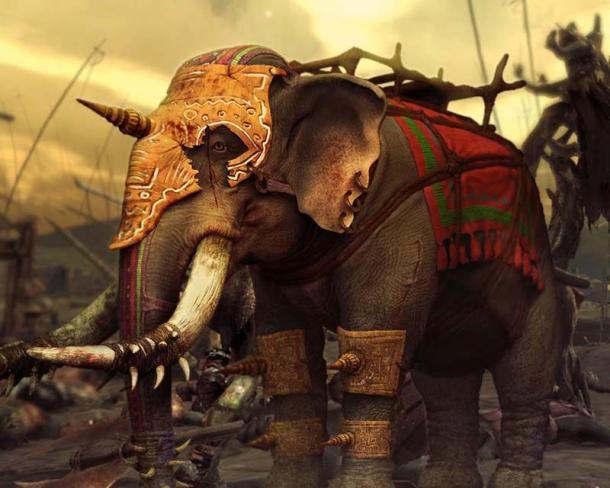
Modern representation of an elephant from ancient Indian warfare. ( CC BY SA )
During Alexander the Great’s invasion of India, the Macedonian army reached as far east as the western borders of Magadha. The armies of Alexander and Dhanananda, however, did not meet each other in battle. This was due to the fact that Alexander’s men mutinied at the Hyphasis. As his men refused to march any further east, the Macedonian king was forced to turn back.
Apart from their military might, the Nanda Dynasty, despite its short rule, is also known to have made a great impact on Indian society. This is reflected in the changes in the material culture of the Ganges River valley. These changes had already begun before the Nandas came to power, i.e. during the 6th and 5th centuries BC, but continued during their reign.
These most important of these was the introduction of settled agricultural technology, and the growing use of iron tools. These two changes led to greater surpluses in agricultural production, increased trade and commerce, and the rise of urban centers. These changes didn’t stop when the Nanda Dynasty fell, but they continued with the succeeding Maurya Dynasty.
Insult and Victory – How the Mauryan Empire was Established
Although Magadha was spared from a war with Alexander the Great, the days of the Nanda Dynasty were numbered. According to the ancient sources, when Alexander invaded India, a Brahmin by the name of Chanakya (known also as Kautilya) travelled to Magadha to offer his services to Dhanananda. Chanakya was, among other things, a shrewd military strategist, and is generally credited as the author of the Arthashastra. This work covers a wide range of topics, including military strategy, economics, and statecraft. Dhanananda, however, dismissed Chanakya from his court following some minor dispute. Chanakya perceived this as an insult, and vowed to have the king overthrown.
On his journey back to Takshashila, Chanakya came across a young boy by the name of Chandragupta Maurya, and recognized the great potential in him. Therefore, the Brahmin took the boy as his student, and began to train him, with the intention of having him overthrow the Nanda Dynasty.
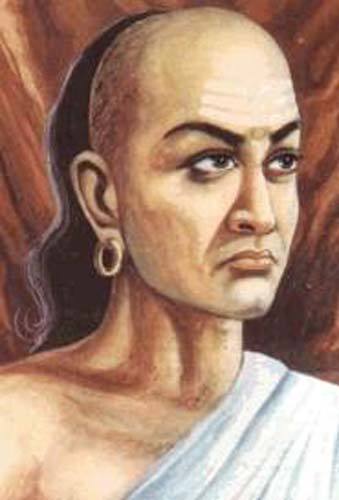
Artistic depiction of Chanakya. ( Public Domain )
Despite the significance of Chandragupta in the history of India, the details about his early life are uncertain, and the various sources often conflict one another. Some sources, for instance, claim that Chandragupta was connected to the Nanda Dynasty. Others argue that he belonged to the Moriyas, a Kshatriya (warrior) class from Pippalivana. It is from the name of this warrior class that the name ‘Maurya’ is supposedly derived.
In any event, once Chandragupta had completed his training under Chanakya, the two attacked Dhanananda, and overthrew him. One important factor behind Chandragupta’s victory was his alliance with Parvatka (sometimes identified as Porus), a Himalayan king. The alliance with this powerful ruler swelled the ranks of Chandragupta’s army with soldiers from many different nations, including the Yavanas (Greeks), Kambojas, Shakas (Scythians), Kiratas (Nepalese), Parasikas (Persians), and Bahlikas (Bactrians). Thus, Chandragupta was able to defeat Dhanananda.
Ancient sources claim that Dhanananda was a corrupt and oppressive ruler who was hated by his subjects. According to Quintus Rufus Curtius, Porus had told Alexander that Dhanananda’s father had originally been a barber. As a result of his good looks, however, he caught the attention of queen. Dhanananda’s father became close friends with the king of Magadha, then treacherously killed him. He then killed the dead king’s children, and had Dhanananda with the queen. Porus concluded his story by saying that Dhanananda was “hated and despised by his subjects”.
Although Chandragupta managed to defeat Dhanananda’s army, the king’s unpopularity among his subjects also contributed to his downfall. As the Magadhan and Mauryan armies were engaged in battle, agents of Chandragupta infiltrated Pataliputra, the capital of Magadha, to stir the sentiments of the population against the king. As a consequence, the kingdom was on the brink of a civil war. In the end, however, Dhanananda is said to have abdicated, and handed over the throne to Chandragupta. He then went into exile, and disappears from history. Thus, the Mauryan Empire was established.
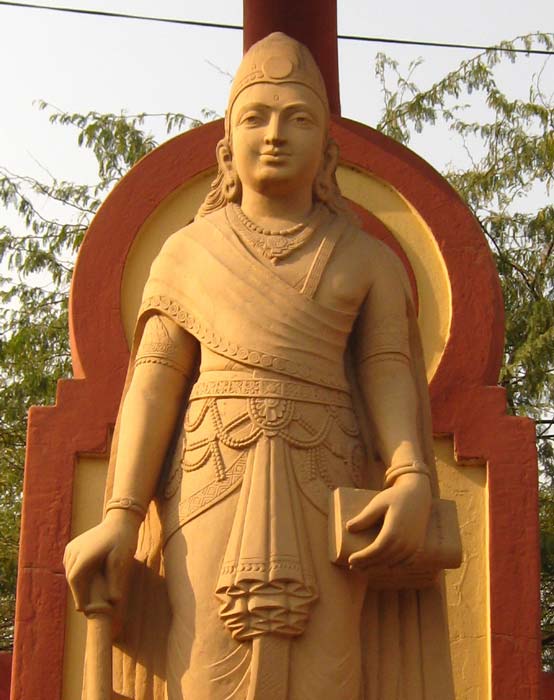
A modern statue depicting Chandragupta Maurya, Laxminarayan Temple, Delhi. ( Public Domain )
A Lull in Magadha’s History
Although Magadha was the core of the Mauryan Empire, Chandragupta and his successors expanded the empire, until almost the entire Indian subcontinent was under their rule. The Mauryan Empire reached its height during the 3rd century BC, when it was ruled by Ashoka the Great, the grandson of Chandragupta. Following Ashoka’s death, however, the empire was ruled by a series of weaker kings, and was therefore experiencing a gradual decline in the decades that followed. The Maurya Empire ended in 185 BC, when its last ruler, Brhadrata, was assassinated by one of his generals, Pusyamitra Shunga.
The Shinga Dynasty lasted about a century, though not much is known about them. Moreover, compared to the Mauryas, the Shungas controlled a much smaller area of India. The Shunga Dynasty was succeeded by the Kanva Dynasty, which ruled for about 50 years. The Kanvas were even weaker than the Shungas, and after their demise, Magadha ceased to be an important region in India for several centuries. It was only during the 4th century AD that the fortunes of Magadha were revived, thanks to the Gupta Empire.
A Golden Age and the Archaeology of Magadha Comes to Light
The Gupta Empire was established by Chandra Gupta I around the beginning of the 4th century AD, and was centered around Magadha. Chandra Gupta and his successors expanded their empire from Magadha, and eventually came to rule much of northern India. The empire reached its height during the early 5th century AD, during the reign of Chandra Gupta II.
During this period, the Gupta Empire was also in control of the eastern coast of India. Apart from territorial expansions, the Gupta period is also known for its cultural and intellectual achievements, and hence their rule is considered to be the golden age of Indian culture. By the middle of 5th century AD, however, the Gupta Empire began to decline, and finally came to an end in the middle of the following century. The end of the Gupta Empire also marks the end of Magadha as a significant state in India.
Although Magadha had lost its importance, its capital, Pataliputra, was more fortunate. The demise of the Gupta Empire led to the decline of Pataliputra, and eventually, the city was abandoned by the 7th century AD. In 1541, however, the site was re-founded by Sher Shah Suri, who renamed it as Patna. This city prospered under the Mughals, and later fell into the hands of the British in 1765.
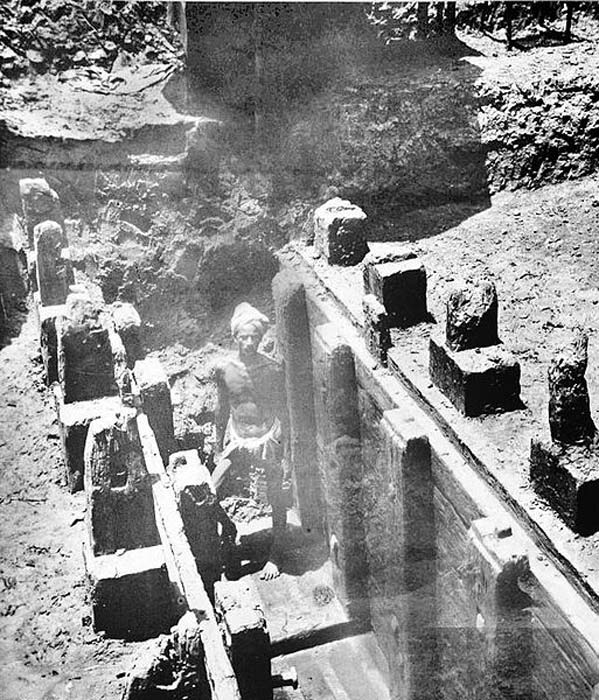
Mauryan remains of wooden palisade at Bulandi Bagh site of Pataliputra. ( Public Domain )
Archaeological work has been conducted in the vicinity of Patna as early as the beginning of the 20th century, which has served to shed some light on Magadha. Still, many uncertainties remain, and perhaps only future excavations at the site will lead to a greater understanding of this period of Indian history.
Top image: Royal procession leaving Rajagriha (Rajgir), the first capital of Magadha Kingdom. Source: Bernard Gagnon/ CC BY-SA 3.0
By Wu Mingren
References
Dalal, K., 2019. Magadha & the First Empire (543 – 330 BCE). [Online]
Available at: https://www.livehistoryindia.com/cover-story/2019/11/17/magadha-the-first-empire-543-330-bce
New World Encyclopedia, 2018. Magadha. [Online]
Available at: https://www.newworldencyclopedia.org/entry/Magadha
New World Encyclopedia, 2018. Maurya Empire. [Online]
Available at: https://www.newworldencyclopedia.org/entry/Maurya_Empire
New World Encyclopedia, 2021. Bimbisara, King. [Online]
Available at: https://www.newworldencyclopedia.org/entry/Bimbisara,_King
New World Encyclopedia, 2021. Chandragupta Maurya. [Online]
Available at: https://www.newworldencyclopedia.org/entry/Chandragupta_Maurya
Quintus Rufus Curtius, History of Alexander: Vol. II [Online]
[Rolfe, J. C. (trans.), 1946. Quintus Rufus Curtius’, History of Alexander: Vol. II .]
Available at: http://babel.hathitrust.org/cgi/pt?id=mdp.39015008158407;view=1up;seq=1
Soka Gakkai, 2021. Magadha. [Online]
Available at: https://www.nichirenlibrary.org/en/dic/Content/M/6
The Editors of Encyclopaedia Britannica, 2009. Bimbisara. [Online]
Available at: https://www.britannica.com/biography/Bimbisara
The Editors of Encyclopaedia Britannica, 2010. Nanda dynasty. [Online]
Available at: https://www.britannica.com/topic/Nanda-dynasty
The Editors of Encyclopaedia Britannica, 2012. Shaishunaga dynasty. [Online]
Available at: https://www.britannica.com/topic/Shaishunaga-dynasty
The Editors of Encyclopaedia Britannica, 2017. Magadha. [Online]
Available at: https://www.britannica.com/place/Magadha
The Editors of Encyclopaedia Britannica, 2017. Patna. [Online]
Available at: https://www.britannica.com/place/Patna
The Editors of Encyclopaedia Britannica, 2019. Gupta dynasty. [Online]
Available at: https://www.britannica.com/topic/Gupta-dynasty
Related posts:
Views: 0
 RSS Feed
RSS Feed
















 February 15th, 2021
February 15th, 2021  Awake Goy
Awake Goy  Posted in
Posted in  Tags:
Tags: 
















